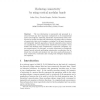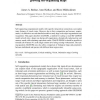21 search results - page 1 / 5 » Reducing connectivity by using cortical modular bands |
ESANN
2004
14 years 7 days ago
2004
The way information is represented and processed in a neural network may have important consequences on its computational power and complexity. Basically, information representatio...
ISBI
2008
IEEE
14 years 11 months ago
2008
IEEE
This work exploits the idea that each individual brain region has a specific connection profile to create parcellations of the cortical surface using MR diffusion imaging. The par...
NN
2006
Springer
13 years 10 months ago
2006
Springer
Neurons in area V 2 and V 4 exhibit stimulus specific tuning to single stimuli, and respond at intermediate firing rates when presented with two differentially preferred stimuli (...
IJON
2002
13 years 10 months ago
2002
Self-organizing computational models with specific intracortical connections can explain many features of visual cortex. However, due to their computation and memory requirements,...
BMCBI
2007
13 years 11 months ago
2007
Background: Combinatorial complexity is a challenging problem in detailed and mechanistic mathematical modeling of signal transduction. This subject has been discussed intensively...


